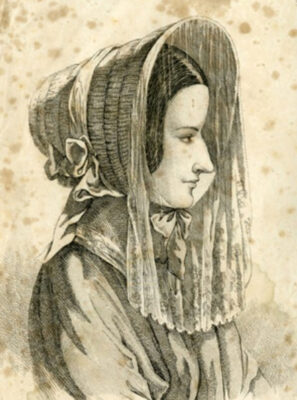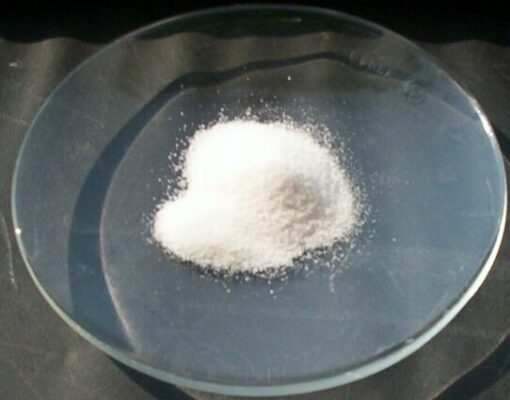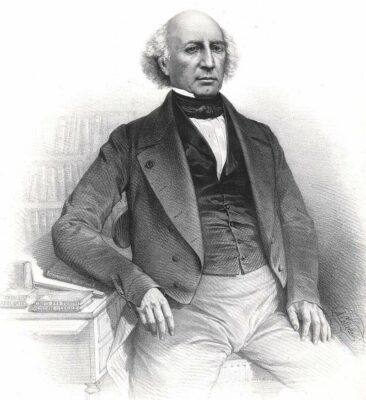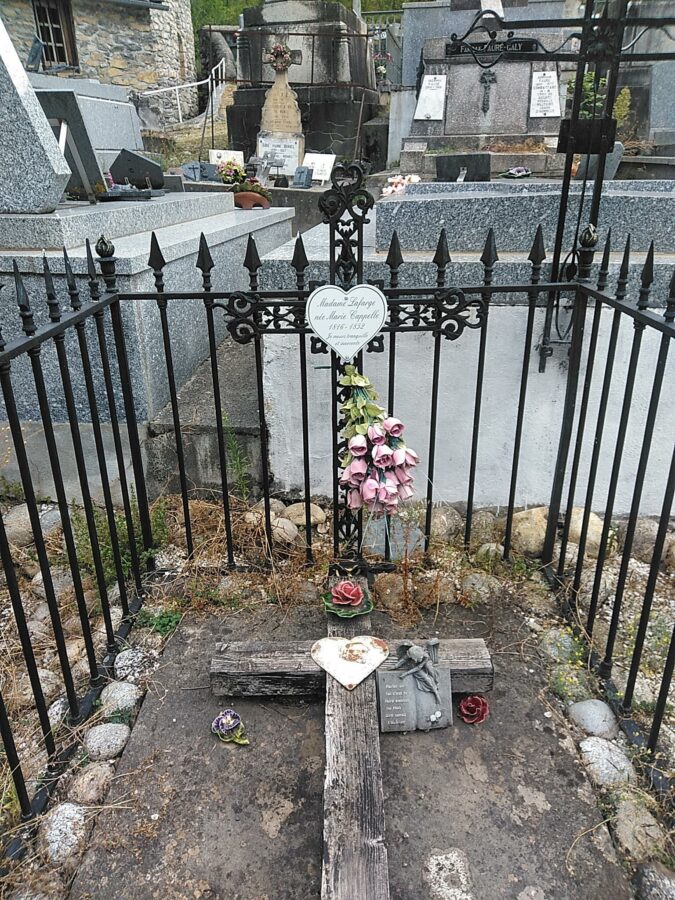
Marie Fortunée Capelle was born in Paris on January 15, 1816. She will remain in history for her name Marital Marie Lafarge.
She died in Ornolac on September 7, 1852.
Marie Lafarge is suspected, then found guilty by the justice of the time of having poisoned her husband, Charles Pouch-Lafarge. The Lafarge affair, the trial of which was the subject of numerous comments and which will be at the origin of numerous works describing or analyzing the case, as well as films in cinema and television.
Marie Lafarge was sentenced in 1840 to forced labor perpetuated by the Tulle Assize Court and to the exhibition on the public square of this city.
Marie Lafarge benefited from a presidential grace on the part of Prince-President Louis-Napoleon Bonaparte, shortly before his death, in 1852. His tomb was located in the cemetery of Ornolac-Ussat-les-Bains.
Origin and youth of Marie Lafarge
Marie Capelle was born in a good family and in Aisne receives an excellent education.
Her maternal grandmother Herminie Compton would have been born from a connection between the Countess Félicité de Genlis and the Duke of Orleans Philippe Equality. This supposed ancestry will have a considerable influence during his trial, which takes place during the July monarchy and the reign of Louis-Philippe, legitimate son of Philippe Equality. The press, which the power had muzzled by the laws of September 1835, was going to hasten to denounce this "Orleanist bastard which became poisonous", and that could have waved the throne.
The father of Marie, former colonel of artillery of the Imperial Guard and officer of the Legion of Honor, died of a hunting accident on November 10, 1828. Marie was twelve years old ... His mother remarried and died seven years later ...
Looking for romantic love, Marie declines all marriage proposals. She asked in engagement the Count Charles Charpentier, son of General Henri François Marie Charpentier, who lives in a neighboring castle in Oigny-en-Valois, but the count does not seem to take this marriage very seriously. The count refuses marriage ...
According to major criminal cases, published by Courtille editions, Marie then got to know the young Denis Guyot, whose presence and elegance she appreciates, and with whom she maintains a purely epistolary affair. The young bourgeois does not seem in a hurry to marry. The uncle of Marie Mr. Baron Garat, governor of the Banque de France, asks that he be put an end to this relationship. Marie obeys him and leaves her pretender from the next day. When he learns the arrest and the conviction of the young woman, Denis Guyot will end her life ...
At twenty-three, with the help of his uncle Baron Garat, who contacted a matrimonial agency, Marie Fortunée Capelle meets an entrepreneur from Corrèze, Charles Lafarge, five years older. Master of forges at the glans, in the commune of Beyssac, he is also the mayor of this town. During the interview, Charles and Marie report their guarantees and their good manners then, not without precipitation, marriage was celebrated on August 11, 1839 in the Notre-Dame-des-Victoires church.
From idyllic love to disappointment ...
Croubling under financial difficulties, Charles Lafarge knows that by marrying him, he will receive a dowry of 80,000 gold francs which will allow him to avoid bankruptcy. Often presented as a "brave man, but a little gruff", he is according to other echoes a vile and corrupt character, plagued by violence, also subject to epilepsy crises ...
Marie will go from surprise as a unpleasant surprise: the new home of her brand new husband is an old dilapidated hone, infested with rats, and that some farmers are declared haunted ... Her husband lied to her. He made him believe that he was the owner of the Pompadour castle in Arnac-Pompadour, which was not the case ...
Desperate, Marie Lafarge takes refuge in her room and wrote a letter to her husband. Marie begs her husband to let her go. She leaves her dowry in exchange. Marie even threatens to end her life.
Her husband refuses clearly. Marie returns to better feelings towards her husband. But in secret she gets in search of money. She will use all means until she made a will in favor of her husband. She even addresses torrid love letters to him ...
In return her husband, affected by these gestures or calculator, made a will in his favor, bequeathing all her property to her. But in the wake her husband redid a will in favor of her mother and her sister ...
Marie writes at the Eyssartier pharmacy of Uzerche in order to obtain death from the rats, because according to her own statements his home is infested with rats.
It is one of the servants, Denis Barbier, a small Parisian crook met in Paris by Charles Lafarge, who is responsible for going to recover the product. Barbier is actually a key man in the case because it is he who will launch the thesis of poisoning ...
Marie also asks her cook to make cakes to send them to her husband. After a four -day diligence trip, on December 18, 1839, pastries, made with unpasteurized milk arrived at their destination. The same day, Baron Lafarge falls seriously ill. Charles Lafarge is taken many vomiting and migraines. He then decided to shorten his stay in Paris and returned to Beyssac. He arrived at the glans on January 3, 1840, and brought in the family doctor, who diagnosed a banal angina. Marie undertakes to treat her husband.

At the same time, she again sends a letter to Mr. Eyssartier, the pharmacist of Uzerche, in order to obtain once again from death to rats ...
The state of Charles suddenly worsens and the doctor recalled at his bedside remains helpless. He died in excruciating suffering, eleven days after his return, January 14, 1840 at 6 am ...
The mother of the deceased has already made the noise run that his daughter-in-law poisoned her son and immediately warns the king's prosecutor.
An instruction is open. The day after the death, the gendarmerie searches and discovers arsenic everywhere: on furniture, food, from the cellar to the attic. Of the fifteen toxicological analyzes carried out on the body of Charles Lafarge, the doctors of the time find only once the presence "of a minimal trace of arsenic". On January 16, 1840, an autopsy was practiced but it did not reveal any anomaly. Organs are however taken to be subject to subsequent expertise.
On the morning of January 23, 1840, Brigadier Magne and the Déon gendarme arrested Marie Capelle-Lafarge, at her home in Glandier and led her to the Brive remand center. On January 31, 1840, Jacques Antoine DESROTE, police commissioner of the city of Paris, proceeded to the search of the apartment of Charles Lafarge in Paris, in order to seek possible fragments of cakes. No suspect is found.
At the beginning of February, the Count of Léautaud accused Marie Lafarge of the flight of a diamond adornment belonging to the Countess. On February 10, diamonds were discovered hidden in the wall of Marie's room ...
The trial begins ... with an expert battle:
After the analyzes carried out by chemists from Tulle and Limoges who have not detected any trace of arsenic, the public prosecutor requests a new autopsy of the body of Charles Lafarge.
During the trial, the track of food poisoning was not addressed. Charles Lafarge felt bad after the absorption of cabbage to the cream sent by his wife, hence the accusation of poisoning. But he was able to die just as well because of the cakes made of cream and butter, unpasteurized and which had traveled three days ...

Mathieu Orfila, dean of the Faculty of Medicine of Paris, inventor of forensic toxicology and one of the authors of the marsh manual of Marsh which detects the traces of Arsenic, an official prince of science and royalist convinced close to Orleanist power, is dispatched from Paris. To everyone's surprise, he is by manipulations, considered today as doubtful, a minimal quantity of arsenic in the body of the deceased. As soon as after having made his testimony, he leaves for Paris by taking in his luggage the reagents used for counter-expertise.
The presence of arsenic in the Lafarge body therefore constitutes the common thread of the trial. Maître Théodore Bac understood it well and tries everything for everything: he asks Raspail, a brilliant chemist of Paris, to put his science at the service of defense. Raspail puts thirty-six hours to arrive in Tulle, but when it arrived, it's been four hours since the jury spoke. It is too late to demonstrate a so -called "natural" presence of arsenic in all human bodies - human bones contain arsenic ...
On September 19, 1840, Marie Lafarge was sentenced to forced labor for perpetuity and an hour -long exhibition sentence in the Tulle public square ...
The impact of the case was, at the time, considerable. The social environment of Marie Capelle-Lafarge and her probable cousinage with King Louis-Philippe, his personality, the enigma of poisoning, contribute to it.
Critics are rolling out of conservative and Catholic ranks. The supporters are rather intellectuals and modernists, who see this presumption of guilt take precedence over the inconsistency of evidence, like Alexandre Dumas or George Sand. The letter woman thus evokes, in response to Eugène Delacroix, in a letter that it is a "poorly conducted affair and badly prosecuted by the public prosecutor"
Detention and death:
Marie Lafarge is sent to the prison of Toulon. The rapid degradation of his state of health will lead Louis-Philippe to commute his sentence in perpetuity criminal detention.
Transferred in one of the towers of Montpellier prison, she contracts tuberculosis. For this reason, the Minister of the Interior Pierre Jules Baroche accepts his transfer to the Saint-Rémy-de-Provence health center.
Prince-President Louis-Napoleon Bonaparte La Gracie by decree and she was released in June 1852.
She died on September 7 of the same year in Ornolac Ussat-les-Bains, our small thermal town located in the Ariège department, where she withdrew. Marie Lafarge is buried in the cemetery of Ornolac-Ussat-les-Bains a few hundred meters from the Ariège Evasion campsite .
Throughout her imprisonment, she wrote a diary published under the title "Hours in prison", where Alexandre Dumas sees "the beats of the heart of the prisoner during these nine years".
Maître Lachaud, his defender during his trial, will not cease to maintain his grave after his death and, when, thirty years later, himself was won by the disease, he asked the wife of Paul de Cassagnac to continue to flower the tomb:
“Cœurs who believe in the innocence of Marie Capelle are becoming increasingly rare. Since you are one of them, promise me to maintain his grave when I am dead ... This thought will do me good. »»
Charles Lachaud

Posterity of the case
A judicial enigma
"Blow mounted", "miscarriage of judicial", "perfect crime", are terms sometimes used to describe or to comment "the Lafarge affair" which remains, according to many specialists in criminal history, one of the greatest judicial puzzles. Like other not completely elucidated cases, it leaves many doubts.
Many writers, journalists and lawyers are still interested today in this suspicious death.
An investigation carried out in 1978 demonstrated that Charles Lafarge would in reality have died of typhoid fever, whose bacillus was in the time poorly identified.
The genealogist Chantal Sobieniak, doing research in 2010 on a justice case in Brive, discovers in a procedural bag, 52 documents concerning a trial deemed in 1818 questioning the Lafarge family and more particularly the mother-in-law of Marie Capelle, Adélaïde Pontier, which gives rise to the publication of the work "twists and turns in the Lafarge case".
In 2011, more than 170 years after the trial and the conviction of Marie Lafarge, family members wish to launch a procedure for revising her trial.
Michel Gache, president of the association "Cercle Marie Capelle-Marie Lafarge", and Edouard de Lamaze, lawyer and great-grand-nephew of Marie Lafarge, declare that they have "gathered enough new elements to reopen the file.
The association, which has given the file to the Ministry of Justice, indicates that it was indeed filed on the office of the Keeper of the Seals. The collective is awaiting a response from the Ministry of Justice ...
A reconstruction of the trial was organized in the Tulle court on October 2, 2023 in the presence of 250 people in the context of "La Nuit du Droit".

